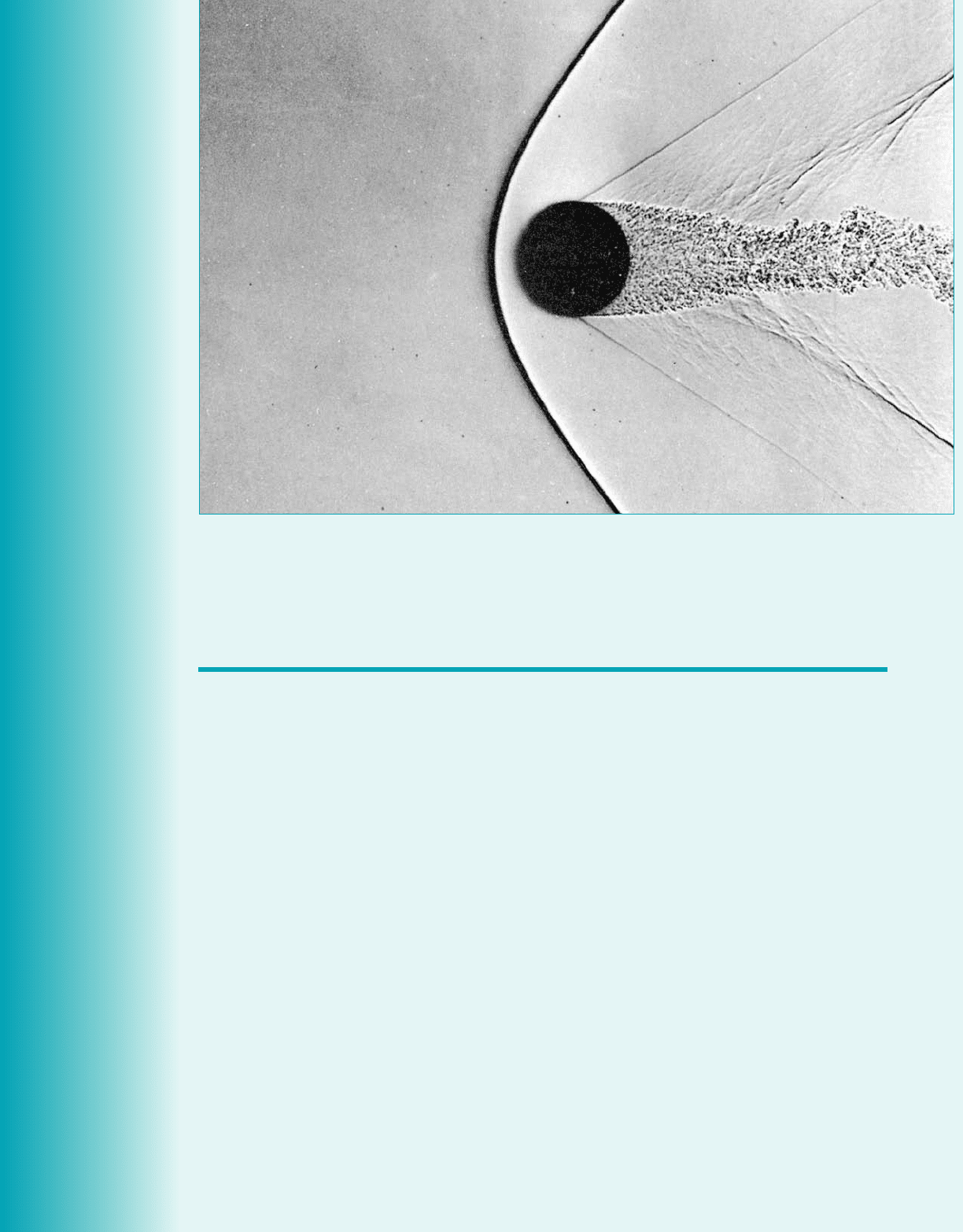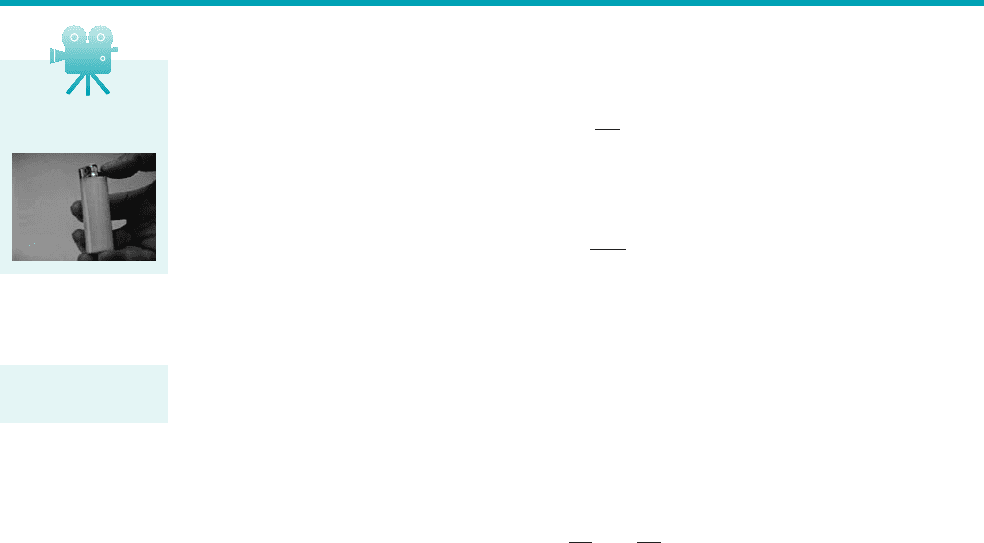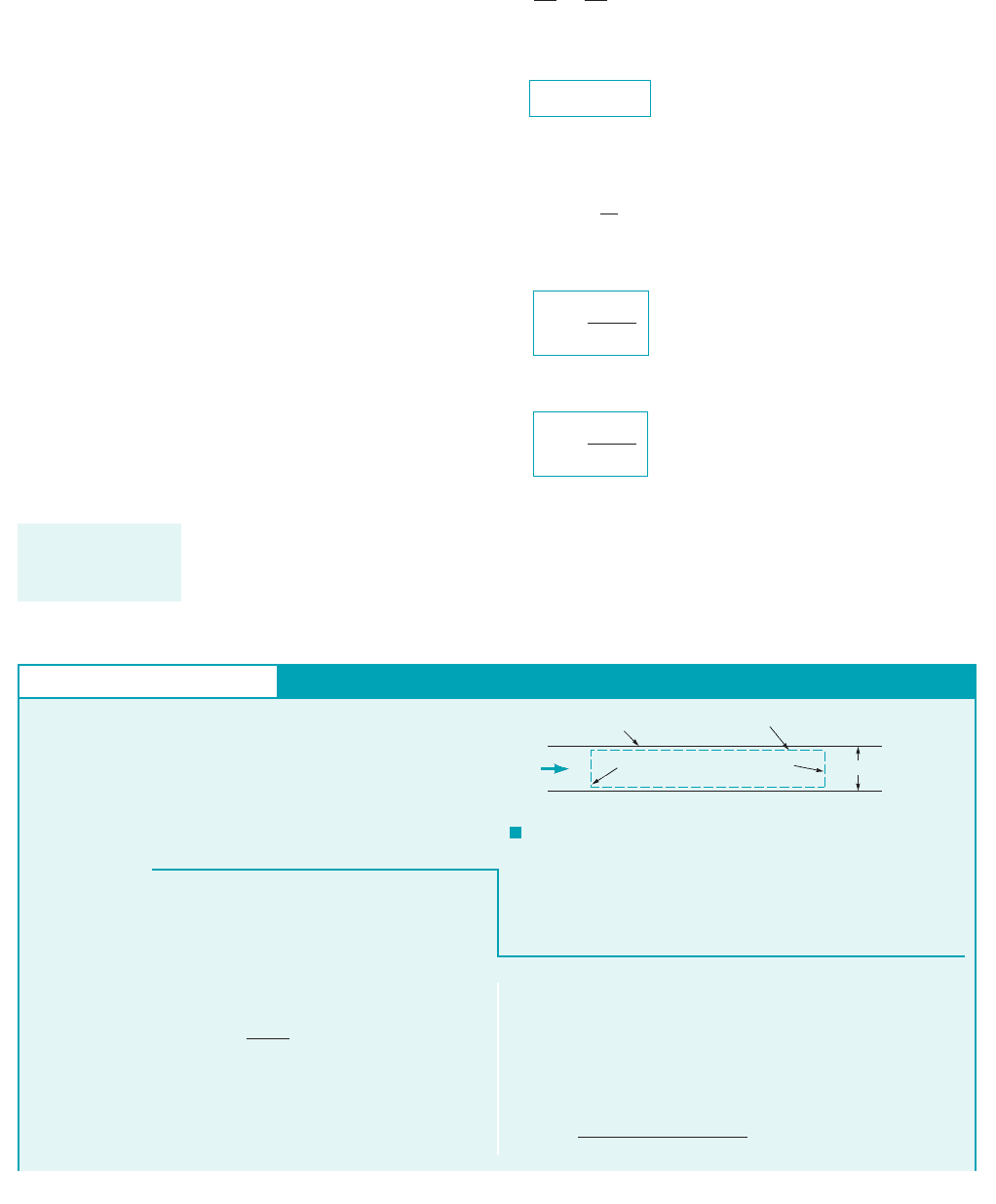Munson B.R. Fundamentals of Fluid Mechanics
Подождите немного. Документ загружается.


10.105 Water flows from a storage tank, over two triangular
weirs, and into two irrigation channels as shown in Video V10.13
and Fig. P10.105. The head for each weir is 0.4 ft, and the flowrate
in the channel fed by the 90°-V-notch weir is to be twice the
flowrate in the other channel. Determine the angle for the second
weir.
u
Problems
577
calculations if the weir of part (a) is replaced by a rectangular sharp-
crested “duck bill” weir which is oriented at an angle of 30° relative
to the channel centerline as shown in Fig. P10.109b. The weir
coefficient remains the same.
10.110 Water flows in a rectangular channel of width at
a rate of The flowrate is to be measured by using either a
rectangular weir of height or a triangular sharp-
crested weir. Determine the head, H, necessary. If measurement of
the head is accurate to only determine the accuracy of the
measured flowrate expected for each of the weirs. Which weir would
be the most accurate? Explain.
Section 10.6.4 Underflow Gates
10.111 Water flows under a sluice gate in a 60-ft-wide finished
concrete channel as is shown in Fig. P10.111. Determine the
flowrate. If the slope of the channel is will the water
depth increase or decrease downstream of the gate? Assume
Explain.C
c
y
2
a 0.65.
2.5 ft
200 ft,
0.04 ft,
1u 90°2P
w
4 ft
100 ft
3
s.
b 20 ft
F I G U R E P10.105
90°
0.4 ft
θ
F I G U R E P10.106
5 ft
H
P
w
= 2 ft
10.106 Rain water from a parking lot flows into a 2-acre 18.71
10
4
ft
2
2retention pond. After a heavy rain when there is no
more inflow into the pond, the rectangular weir shown in Fig.
P10.106 at the outlet of the pond has a head of (a)
Determine the rate at which the level of the water in the pond
decreases, at this condition. (b) Determine how long it
will take to reduce the pond level by half a foot; that is, to
ft.H 0.1
dH
dt,
H 0.6 ft.
F I G U R E P10.109
(a)(b)
20 ft
Q Q
30°
F I G U R E P10.111
a = 2 ft
y
2
10 ft
Q
F I G U R E P10.113
1m
2m
2m
y
1
10.107 A basin at a water treatment plant is 60 ft long, 10 ft wide,
and 5 ft deep. Water flows from the basin over a 3-ft-long,
rectangular weir whose crest is 4 ft above the bottom of the basin.
Estimate how long it will take for the depth of the water in the
basin to change from 4.5 ft to 4.4 ft if there is no flow into the
basin.
10.108 Water flows over a sharp-crested triangular weir with
The head range covered is 0 and the
accuracy in the measurement of the head, H, is
Plot a graph of the percent error expected in Q as a function of Q.
10.109 (a) The rectangular sharp-crested weir shown in Fig.
P10.109a is used to maintain a relatively constant depth in the
channel upstream of the weir. How much deeper will the water be
upstream of the weir during a flood when the flowrate is
compared to normal conditions when the flowrate is Assume
the weir coefficient remains constant at (b) Repeat theC
wr
0.62.
30 ft
3
s?
45 ft
3
s
dH ;0.01 ft.
.20 H 1.0 ftu 90°.
10.112 Water flows under a sluice gate in a channel of 10-ft width.
If the upstream depth remains constant at 5 ft, plot a graph of
flowrate as a function of the distance between the gate and the
channel bottom as the gate is slowly opened. Assume free outflow.
10.113 A water-level regulator 1not shown2maintains a depth of
2.0 m downstream from a 10-m-wide drum gate as shown in Fig.
P10.113. Plot a graph of flowrate, Q, as a function of water depth
upstream of the gate, for 2.0 y
1
5.0 m.y
1
,
■ Lab Problems
10.114 This problem involves the calibration of a triangular weir.
To proceed with this problem, go to Appendix H which is located
on the book’s web site, www.wiley.com/college/munson.
10.115 This problem involves the calibration of a rectangular
weir. To proceed with this problem, go to Appendix H which is
located on the book’s web site, www.wiley.com/college/munson.
10.116 This problem involves the depth ratio across a hydraulic
jump. To proceed with this problem, go to Appendix H which is
located on the book’s web site, www.wiley.com/college/munson.
10.117 This problem involves the head loss across a hydraulic
jump. To proceed with this problem, go to Appendix H which is
located on the book’s web site, www.wiley.com/college/munson.
JWCL068_ch10_534-578.qxd 9/23/08 11:56 AM Page 577
■ Life Long Learning Problems
10.118 With the increased usage of low-lying coastal areas and
the possible rise in ocean levels because of global warming, the
potential for widespread damage from tsunamis 1i.e., “tidal waves”2
is increasing. Obtain information about new and improved methods
available to predict the occurrence of these damaging waves and
how to better use coastal areas so that massive loss of life and
property does not occur. Summarize your findings in a brief report.
10.119 Recent photographs from NASA’s Mars Orbiter Camera
on the Mars Global Surveyor provide new evidence that water may
still flow on the surface of Mars. Obtain information about the
possibility of current or past open-channel flows on Mars and other
planets or their satellites. Summarize your findings in a brief report.
578 Chapter 10 ■ Open-Channel Flow
10.120 Hydraulic jumps are normally associated with water
flowing in rivers, gullies, and other such relatively high-speed open
channels. However, recently, hydraulic jumps have been used in
various manufacturing processes involving fluids other than water
1such as liquid metal solder2in relatively small-scale flows. Obtain
information about new manufacturing processes that involve
hydraulic jumps as an integral part of the process. Summarize your
findings in a brief report.
■ FE Exam Problems
Sample FE 1Fundamentals of Engineering2exam questions for fluid
mechanics are provided on the book’s web site, www.wiley.com/
college/munson.
JWCL068_ch10_534-578.qxd 9/23/08 11:56 AM Page 578

579
CHAPTER OPENING PHOTO: Flow past a sphere at Mach 1.53: An object moving through a fluid at super-
sonic speed 1Mach number greater than one2creates a shock wave 1a discontinuity in flow conditions shown
by the dark curved line2, which is heard as a sonic boom as the object passes overhead. The turbulent wake
is also shown 1shadowgraph technique used in air2. (Photograph courtesy of A. C. Charters.)
Learning Objectives
After completing this chapter, you should be able to:
■ distinguish between incompressible and compressible flows, and know when the
approximations associated with assuming fluid incompressibility are acceptable.
■ understand some important features of different categories of compressible
flows of ideal gases.
■ explain speed of sound and Mach number and their practical significance.
■ solve useful problems involving isentropic and nonisentropic flows including
flows across normal shock waves.
■ appreciate the compelling similarities between compressible flows of gases
and open channel flows of liquids.
■ move on to understanding more advanced concepts about compressible flows.
Most first courses in fluid mechanics concentrate on constant density 1incompressible2flows. In
earlier chapters of this book, we mainly considered incompressible flow behavior. In a few in-
stances, variable density 1compressible2flow effects were covered briefly. The notion of an incom-
pressible fluid is convenient because when constant density and constant 1including zero2viscos-
ity are assumed, problem solutions are greatly simplified. Also, fluid incompressibility allows us
to build on the Bernoulli equation as was done, for example, in Chapter 5. Preceding examples
should have convinced us that nearly incompressible flows are common in everyday experiences.
11
11
Compressible
Flow
Compressible
Flow
JWCL068_ch11_579-644.qxd 9/25/08 8:17 PM Page 579

Any study of fluid mechanics would, however, be incomplete without a brief introduction to com-
pressible flow behavior. Fluid compressibility is a very important consideration in numerous engineer-
ing applications of fluid mechanics. For example, the measurement of high-speed flow velocities re-
quires compressible flow theory. The flows in gas turbine engine components are generally compressible.
Many aircraft fly fast enough to involve compressible flow.
The variation of fluid density for compressible flows requires attention to density and other
fluid property relationships. The fluid equation of state, often unimportant for incompressible flows,
is vital in the analysis of compressible flows. Also, temperature variations for compressible flows
are usually significant and thus the energy equation is important. Curious phenomena can occur with
compressible flows. For example, with compressible flows we can have fluid acceleration because
of friction, fluid deceleration in a converging duct, fluid temperature decrease with heating, and the
formation of abrupt discontinuities in flows across which fluid properties change appreciably.
For simplicity, in this introductory study of compressibility effects we mainly consider the
steady, one-dimensional, constant 1including zero2viscosity, compressible flow of an ideal gas. We
limit our study to compressibility due to high speed flow. In this chapter, one-dimensional flow
refers to flow involving uniform distributions of fluid properties over any flow cross-sectional area.
Both frictionless and frictional compressible flows are considered. If the change
in volume associated with a change of pressure is considered a measure of compressibility, our ex-
perience suggests that gases and vapors are much more compressible than liquids. We focus our
attention on the compressible flow of a gas because such flows occur often. We limit our discus-
sion to ideal gases, since the equation of state for an ideal gas is uncomplicated, yet representative
of actual gases at pressures and temperatures of engineering interest, and because the flow trends
associated with an ideal gas are generally applicable to other compressible fluids.
An excellent film about compressible flow is available 1see Ref. 12. This resource is a use-
ful supplement to the material covered in this chapter.
1m ⫽ 021m ⫽ 02
580 Chapter 11 ■ Compressible Flow
11.1 Ideal Gas Relationships
Before we can proceed to develop compressible flow equations, we need to become more famil-
iar with the fluid we will work with, the ideal gas. Specifically, we must learn how to evaluate
ideal gas property changes. The equation of state for an ideal gas is
(11.1)
We have already discussed fluid pressure, p, density, and temperature, T, in earlier chapters. The
gas constant, R, represents a constant for each distinct ideal gas or mixture of ideal gases, where
(11.2)
With this notation, is the universal gas constant and is the molecular weight of the ideal gas or
gas mixture. Listed in Tables 1.7 and 1.8 are values of the gas constants of some commonly used gases.
Knowing the pressure and temperature of a gas, we can estimate its density. Nonideal gas state equa-
tions are beyond the scope of this text, and those interested in this topic are directed to texts on engi-
neering thermodynamics, for example, Ref. 2. Note that the trends of ideal gas flows are generally
good indicators of what nonideal gas flow behavior is like.
For an ideal gas, internal energy, is part of the stored energy of the gas as explained in
Section 5.3 and is considered to be a function of temperature only 1Ref. 22. Thus, the ideal gas spe-
cific heat at constant volume, can be expressed as
(11.3)
where the subscript on the partial derivative refers to differentiation at constant specific volume,
From Eq. 11.3 we conclude that for a particular ideal gas, is a function of tempera-
ture only. Equation 11.3 can be rearranged to yield
duˇ ⫽ c
v
dT
c
v
v ⫽ 1
Ⲑ
r.
v
c
v
⫽ a
0uˇ
0T
b
v
⫽
duˇ
dT
c
v
,
uˇ,
M
gas
l
R ⫽
l
M
gas
r,
r ⫽
p
RT
We consider ideal
gas flows only.
V11.1 Lighter
flame
JWCL068_ch11_579-644.qxd 9/25/08 8:17 PM Page 580

Thus,
(11.4)
Equation 11.4 is useful because it allows us to evaluate the change in internal energy, as-
sociated with ideal gas flow from section 112to section 122in a flow. For simplicity, we can assume
that is constant for a particular ideal gas and obtain from Eq. 11.4
(11.5)
Actually, for a particular gas varies with temperature 1see Ref. 22. However, for moderate changes
in temperature, the constant assumption is reasonable.
The fluid property enthalpy, is defined as
(11.6)
It combines internal energy, and pressure energy, and is useful when dealing with the en-
ergy equation 1Eq. 5.692. For an ideal gas, we have already stated that
From the equation of state 1Eq. 11.12
Thus, it follows that
Since for an ideal gas, enthalpy is a function of temperature only, the ideal gas specific heat at con-
stant pressure, can be expressed as
(11.7)
where the subscript p on the partial derivative refers to differentiation at constant pressure, and
is a function of temperature only. The rearrangement of Eq. 11.7 leads to
and
(11.8)
Equation 11.8 is useful because it allows us to evaluate the change in enthalpy, associ-
ated with ideal gas flow from section 112to section 122in a flow. For simplicity, we can assume
that is constant for a specific ideal gas and obtain from Eq. 11.8
(11.9)
As is true for the value of for a given gas varies with temperature. Nevertheless, for moder-
ate changes in temperature, the constant assumption is reasonable.
From Eqs. 11.5 and 11.9 we see that changes in internal energy and enthalpy are related
to changes in temperature by values of and We turn our attention now to developing use-
ful relationships for determining and Combining Eqs. 11.6 and 11.1 we get
(11.10)h
ˇ
⫽ uˇ ⫹ RT
c
p
.c
v
c
p
.c
v
c
p
c
p
c
v
,
h
ˇ
2
⫺ h
ˇ
1
⫽ c
p
1T
2
⫺ T
1
2
c
p
h
ˇ
2
⫺ h
ˇ
1
,
h
ˇ
2
⫺ h
ˇ
1
⫽
冮
T
2
T
1
c
p
dT
dh
ˇ
⫽ c
p
dT
c
p
c
p
⫽ a
0h
ˇ
0T
b
p
⫽
dh
ˇ
dT
c
p
,
h
ˇ
⫽ h
ˇ
1T2
p
r
⫽ RT
uˇ ⫽ uˇ1T2
p
Ⲑ
r,uˇ,
h
ˇ
⫽ uˇ ⫹
p
r
h
ˇ
,
c
v
c
v
uˇ
2
⫺ uˇ
1
⫽ c
v
1T
2
⫺ T
1
2
c
v
uˇ
2
⫺ uˇ
1
,
uˇ
2
⫺ uˇ
1
⫽
冮
T
2
T
1
c
v
dT
11.1 Ideal Gas Relationships 581
For moderate tem-
perature changes,
specific heat values
can be considered
constant.
JWCL068_ch11_579-644.qxd 9/25/08 8:17 PM Page 581

Differentiating Eq. 11.10 leads to
or
(11.11)
From Eqs. 11.3, 11.7, and 11.11 we conclude that
(11.12)
Equation 11.12 indicates that the difference between and is constant for each ideal gas re-
gardless of temperature. Also If the specific heat ratio, k, is defined as
(11.13)
then combining Eqs. 11.12 and 11.13 leads to
(11.14)
and
(11.15)
Actually, and k are all somewhat temperature dependent for any ideal gas. We will assume
constant values for these variables in this book. Values of k and R for some commonly used gases at
nominal temperatures are listed in Tables 1.7 and 1.8. These tabulated values can be used with Eqs.
11.13 and 11.14 to determine the values of and Example 11.1 demonstrates how internal en-
ergy and enthalpy changes can be calculated for a flowing ideal gas having constant and c
v
.c
p
c
v
.c
p
c
p
, c
v
,
c
v
⫽
R
k ⫺ 1
c
p
⫽
Rk
k ⫺ 1
k ⫽
c
p
c
v
c
p
7 c
v
.
c
v
c
p
c
p
⫺ c
v
⫽ R
dh
ˇ
dT
⫽
duˇ
dT
⫹ R
dh
ˇ
⫽ duˇ ⫹ R dT
582 Chapter 11 ■ Compressible Flow
The gas constant is
related to the spe-
cific heat values.
GIVEN Air flows steadily between two sections in a long
straight portion of 4-in.-diameter pipe as is indicated in Fig. E11.1.
The uniformly distributed temperature and pressure at each section
are psia, and psia. T
2
⫽ 453 °R, p
2
⫽ 18.4T
1
⫽ 540 °R, p
1
⫽ 100
Internal Energy, Enthalpy, and Density for an Ideal Gas
E
XAMPLE 11.1
S
OLUTION
units are used more often than British Gravitational System units
in compressible flow discussions, we use
to get
R ⫽
1716 1ft
#
lb2
Ⲑ
1slug
#
°R2
32.174 1lbm
Ⲑ
slug2
⫽ 53.3 1ft
#
lb2
Ⲑ
1lbm
#
°R2
1 slug ⫽ 32.174 lbm
(a) Assuming air behaves as an ideal gas, we can use Eq. 11.5 to
evaluate the change in internal energy between sections 112and 122.
Thus
(1)
From Eq. 11.15 we have
(2)
and from Table 1.7, and
Throughout this book, we use the nominal values of k for
common gases listed in Tables 1.7 and 1.8 and consider these val-
ues as being representative. Since English Engineering System
k ⫽ 1.4.R ⫽ 1716 1ft
#
lb2
Ⲑ
1slug
#
°R2
c
v
⫽
R
k ⫺ 1
uˇ
2
⫺ uˇ
1
⫽ c
v
1T
2
⫺ T
1
2
F I G U R E E11.1
D
Section (2)
Section (1)
Flow
Control volume
Pipe
D
1
= D
2
= 4 in.
FIND Calculate the 1a2change in internal energy between sec-
tions 112and 122, 1b2change in enthalpy between sections 112and
122, and 1c2change in density between sections 112and 122.
JWCL068_ch11_579-644.qxd 9/25/08 8:17 PM Page 582

For compressible flows, changes in the thermodynamic property entropy, s, are important.
For any pure substance including ideal gases, the “first T ds equation” is 1see Ref. 22
(11.16)
where T is absolute temperature, s is entropy, is internal energy, p is absolute pressure, and is
density. Differentiating Eq. 11.6 leads to
(11.17)
By combining Eqs. 11.16 and 11.17, we obtain
(11.18)
Equation 11.18 is often referred to as the “second T ds equation.” For an ideal gas, Eqs. 11.1, 11.3,
and 11.16 can be combined to yield
(11.19)
and Eqs. 11.1, 11.7, and 11.18 can be combined to yield
(11.20)ds ⫽ c
p
dT
T
⫺ R
dp
p
ds ⫽ c
v
dT
T
⫹
R
1
Ⲑ
r
d a
1
r
b
T ds ⫽ dh
ˇ
⫺ a
1
r
b dp
dh
ˇ
⫽ duˇ ⫹ pd a
1
r
b⫹ a
1
r
b dp
ruˇ
T ds ⫽ duˇ ⫹ pd a
1
r
b
11.1 Ideal Gas Relationships 583
From Eq. 2 we obtain
(3)
Combining Eqs. 1 and 3 yields
(Ans)
Or, if Btu are wanted as energy units, we note that
and so
(b) For enthalpy change we use Eq. 11.9. Thus
(4)
where since we obtain
(5)
From Eqs. 4 and 5 we obtain
(Ans)
⫽⫺16,200 ft
#
lb
Ⲑ
lbm
⫻ 1453 °R ⫺ 540 °R2
h
ˇ
2
⫺ h
ˇ
1
⫽ c
p
1T
2
⫺ T
1
2⫽ 186 1ft
#
lb2
Ⲑ
1lbm
#
°R2
⫽ 186 1ft
#
lb2
Ⲑ
1lbm
#
°R2
c
p
⫽ kc
v
⫽ 11.423133 1ft
#
lb2
Ⲑ
1lbm
#
°R24
k ⫽ c
p
Ⲑ
c
v
h
ˇ
2
⫺ h
ˇ
1
⫽ c
p
1T
2
⫺ T
1
2
uˇ
2
⫺ uˇ
1
⫽⫺
11,600 1ft
#
lb2
Ⲑ
lbm
778 1ft
#
lb2
Ⲑ
Btu
⫽⫺14.9 Btu
Ⲑ
lbm
778 ft
#
lb ⫽ 1 Btu
⫽⫺11,600 ft
#
lb
Ⲑ
lbm
⫻ 1453 °R ⫺ 540 °R2
uˇ
2
⫺ uˇ
1
⫽ c
v
1T
2
⫺ T
1
2⫽ 133 1ft
#
lb2
Ⲑ
1lbm
#
°R2
⫽ 133 1ft
#
lb2
Ⲑ
1lbm
#
°R2
c
v
⫽
53.3
11.4 ⫺ 12
1ft
#
lb2
Ⲑ
1lbm
#
°R2
(c) For density change we use the ideal gas equation of state
1Eq. 11.12to get
(6)
Using the pressures and temperatures given in the problem state-
ment we calculate from Eq. 6
or
(Ans)
COMMENT This is a significant change in density when
compared with the upstream density
Compressibility effects are important for this flow.
⫽ 0.499 lbm
Ⲑ
ft
3
r
1
⫽
p
1
RT
1
⫽
1100 psia21144 in.
2
Ⲑ
ft
2
2
353.3 1ft
#
lb2
Ⲑ
1lbm
#
°R241540 °R2
r
2
⫺ r
1
⫽⫺0.389 lbm
Ⲑ
ft
3
⫺
1100 psia21144 in.
2
Ⲑ
ft
2
2
540 °R
d
⫻ c
118.4 psia21144 in.
2
Ⲑ
ft
2
2
453 °R
r
2
⫺ r
1
⫽
1
53.3 1ft
#
lb2
Ⲑ
1lbm
#
°R2
r
2
⫺ r
1
⫽
p
2
RT
2
⫺
p
1
RT
1
⫽
1
R
a
p
2
T
2
⫺
p
1
T
1
b
Changes in entropy
are important be-
cause they are re-
lated to loss of
available energy.
JWCL068_ch11_579-644.qxd 9/25/08 8:17 PM Page 583

If and are assumed to be constant for a given gas, Eqs. 11.19 and 11.20 can be integrated to get
(11.21)
and
(11.22)
Equations 11.21 and 11.22 allow us to calculate the change of entropy of an ideal gas flowing from
one section to another with constant specific heat values 1 and 2.c
v
c
p
s
2
⫺ s
1
⫽ c
p
ln
T
2
T
1
⫺ R ln
p
2
p
1
s
2
⫺ s
1
⫽ c
v
ln
T
2
T
1
⫹ R ln
r
1
r
2
c
v
c
p
584 Chapter 11 ■ Compressible Flow
Changes in entropy
are related to
changes in temper-
ature, pressure, and
density.
GIVEN Consider the air flow of Example 11.1.
Entropy for an Ideal Gas
E
XAMPLE 11.2
S
OLUTION
we get
or
(Ans)
From Eq. 11.22,
(4)
By substituting known values into Eq. 4 we obtain
or
(Ans)
COMMENT
As anticipated, both Eqs. 11.21 and 11.22 yield
the same result for the entropy change,
Note that since the ideal gas equation of state was used in the
derivation of the entropy difference equations, both the pressures
and temperatures used must be absolute.
s
2
⫺ s
1
.
s
2
⫺ s
1
⫽ 57.5 1ft
#
lb2
Ⲑ
1lbm
#
°R2
⫺ 353.3 1ft
#
lb2
Ⲑ
1lbm
#
°R24 ln a
18.4 psia
100 psia
b
s
2
⫺ s
1
⫽ 3186 1ft
#
lb2
Ⲑ
1lbm
#
°R24 ln a
453 °R
540 °R
b
s
2
⫺ s
1
⫽ c
p
ln
T
2
T
1
⫺ R ln
p
2
p
1
s
2
⫺ s
1
⫽ 57.5 1ft
#
lb2
Ⲑ
1lbm
#
°R2
⫹ 353.3 1ft
#
lb2
Ⲑ
1lbm
#
°R24 ln 4.56
s
2
⫺ s
1
⫽ 3133 1ft
#
lb2
Ⲑ
1lbm
#
°R24 ln a
453 °R
540 °R
b
Assuming that the flowing air in Fig. E11.1 behaves as an ideal
gas, we can calculate the entropy change between sections by us-
ing either Eq. 11.21 or Eq. 11.22. We use both to demonstrate that
the same result is obtained either way.
From Eq. 11.21,
(1)
To evaluate from Eq. 1 we need the density ratio,
which can be obtained from the ideal gas equation of state
1Eq. 11.12as
(2)
and thus from Eqs. 1 and 2,
(3)
By substituting values already identified in the Example 11.1
problem statement and solution into Eq. 3 with
a
p
1
T
1
b a
T
2
p
2
b⫽ a
100 psia
540 °R
b a
453 °R
18.4 psia
b⫽ 4.56
s
2
⫺ s
1
⫽ c
v
ln
T
2
T
1
⫹ R ln ca
p
1
T
1
b a
T
2
p
2
bd
r
1
r
2
⫽ a
p
1
T
1
b a
T
2
p
2
b
r
1
Ⲑ
r
2
,s
2
⫺ s
1
s
2
⫺ s
1
⫽ c
v
ln
T
2
T
1
⫹ R ln
r
1
r
2
If internal energy, enthalpy, and entropy changes for ideal gas flow with variable specific heats
are desired, Eqs. 11.4, 11.8, and 11.19 or 11.20 must be used as explained in Ref. 2. Detailed tables
1see, for example, Ref. 32are available for variable specific heat calculations.
The second law of thermodynamics requires that the adiabatic and frictionless flow of any fluid
results in Constant entropy flow is called isentropic flow. For the isentropic
flow of an ideal gas with constant and we get from Eqs. 11.21 and 11.22
(11.23)c
v
ln
T
2
T
1
⫹ R ln
r
1
r
2
⫽ c
p
ln
T
2
T
1
⫺ R ln
p
2
p
1
⫽ 0
c
v
,c
p
ds ⫽ 0 or s
2
⫺ s
1
⫽ 0.
FIND
Calculate the change in entropy, between sec-
tions 112and 122.
s
2
⫺ s
1
,
JWCL068_ch11_579-644.qxd 9/25/08 8:17 PM Page 584

By combining Eq. 11.23 with Eqs. 11.14 and 11.15 we obtain
(11.24)
which is a useful relationship between temperature, density, and pressure for the isentropic flow
of an ideal gas. From Eq. 11.24 we can conclude that
(11.25)
for an ideal gas with constant and flowing isentropically, a result already used without proof
earlier in Chapters 1, 3, and 5.
c
v
c
p
p
r
k
⫽ constant
a
T
2
T
1
b
k
Ⲑ
1k⫺12
⫽ a
r
2
r
1
b
k
⫽ a
p
2
p
1
b
11.2 Mach Number and Speed of Sound 585
Fluids in the News
Hilsch tube (Ranque vortex tube) Years ago (around 1930) a
French physics student (George Ranque) discovered that apprecia-
bly warmer and colder portions of rapidly swirling air flow could be
separated in a simple apparatus consisting of a tube open at both
ends into which was introduced, somewhere in between the two
openings, swirling air at high pressure. Warmer air near the outer
portion of the swirling air flowed out one open end of the tube
through a simple valve and colder air near the inner portion of the
swirling air flowed out the opposite end of the tube. Rudolph
Hilsch, a German physicist, improved on this discovery (ca. 1947).
Hot air temperatures of 260 °F (127 °C) and cold air temperatures
of ⫺50 °F (⫺46 °C) have been claimed in an optimized version of
this apparatus. Thus far the inefficiency of the process has pre-
vented it from being widely adopted. (See Problems 11.80.)
The Mach number, Ma, was introduced in Chapters 1 and 7 as a dimensionless measure of com-
pressibility in a fluid flow. In this and subsequent sections, we develop some useful relationships
involving the Mach number. The Mach number is defined as the ratio of the value of the local flow
velocity, V, to the local speed of sound, c. In other words,
What we perceive as sound generally consists of weak pressure pulses that move through air with
a Mach number of one. When our ear drums respond to a succession of moving pressure pulses,
we hear sounds.
To better understand the notion of speed of sound, we analyze the one-dimensional fluid me-
chanics of an infinitesimally thin, weak pressure pulse moving at the speed of sound through a
fluid at rest 1see Fig. 11.1a2. Ahead of the pressure pulse, the fluid velocity is zero and the fluid
pressure and density are p and Behind the pressure pulse, the fluid velocity has changed by an
amount and the pressure and density of the fluid have also changed by amounts and
We select an infinitesimally thin control volume that moves with the pressure pulse as is sketched
dr.dpdV,
r.
Ma ⫽
V
c
11.2 Mach Number and Speed of Sound
Mach number is
the ratio of local
flow and sound
speeds.
F I G U R E 11.1 (a) Weak pressure pulse moving through a fluid at
rest. (b) The flow relative to a control volume containing a weak pressure pulse.
c
p
AA
V
= 0
ρ
p
V
ρδρ
δ
(a)
Control volume
Weak pressure pulse
+
δρ
+
c
c
p
AA
ρ
p
V
ρδρ
δ
(b)
Control volume
Weak pressure pulse
+
–
δρ
+
JWCL068_ch11_579-644.qxd 9/25/08 8:17 PM Page 585

in Fig. 11.1a. The speed of the weak pressure pulse is considered constant and in one direction
only; thus, our control volume is inertial.
For an observer moving with this control volume 1Fig. 11.1b2, it appears as if fluid is enter-
ing the control volume through surface area A with speed c at pressure p and density and leav-
ing the control volume through surface area A with speed pressure and density
When the continuity equation 1Eq. 5.162is applied to the flow through this control vol-
ume, the result is
(11.26)
or
(11.27)
Since is much smaller than the other terms in Eq. 11.27, we drop it from further consid-
eration and keep
(11.28)
The linear momentum equation 1Eq. 5.292can also be applied to the flow through the control vol-
ume of Fig. 11.1b. The result is
(11.29)
Note that any frictional forces are considered as being negligibly small. We again neglect higher
order terms [such as compared to c for example] and combine Eqs. 11.26 and 11.29
to get
or
(11.30)
From Eqs. 11.28 1continuity2and 11.30 1linear momentum2we obtain
or
(11.31)
This expression for the speed of sound results from application of the conservation of mass and
conservation of linear momentum principles to the flow through the control volume of Fig. 11.1b.
These principles were similarly used in Section 10.2.1 to obtain an expression for the speed of sur-
face waves traveling on the surface of fluid in a channel.
The conservation of energy principle can also be applied to the flow through the control vol-
ume of Fig. 11.1b. If the energy equation 1Eq. 5.1032is used for the flow through this control vol-
ume, the result is
(11.32)
For gas flow we can consider g as being negligibly small in comparison to the other terms in the
equation. Also, if we assume that the flow is frictionless, then and Eq. 11.32 becomes
or, neglecting compared to c we obtain
(11.33)r dV ⫽
dp
c
dV,1dV2
2
dp
r
⫹
1c ⫺ dV2
2
2
⫺
c
2
2
⫽ 0
d1loss2⫽ 0
dz
dp
r
⫹ d a
V
2
2
b⫹ g dz ⫽ d1loss2
c ⫽
B
dp
dr
c
2
⫽
dp
dr
rdV ⫽
dp
c
⫺crcA ⫹ 1c ⫺ dV2rAc ⫽⫺dpA
dV,1dV2
2
⫺crcA ⫹ 1c ⫺ dV21r ⫹ dr21c ⫺ dV2A ⫽ pA ⫺ 1p ⫹ dp2A
r dV ⫽ c dr
1dr21dV2
rc ⫽ rc ⫺ r dV ⫹ c dr ⫺ 1dr21dV2
rAc ⫽ 1r ⫹ dr2A1c ⫺ dV2
r ⫹ dr.
p ⫹ dp,c ⫺ dV,
r
586 Chapter 11 ■ Compressible Flow
The changes in fluid
properties across
a sound wave are
very small compared
to their local values.
JWCL068_ch11_579-644.qxd 9/25/08 8:17 PM Page 586
